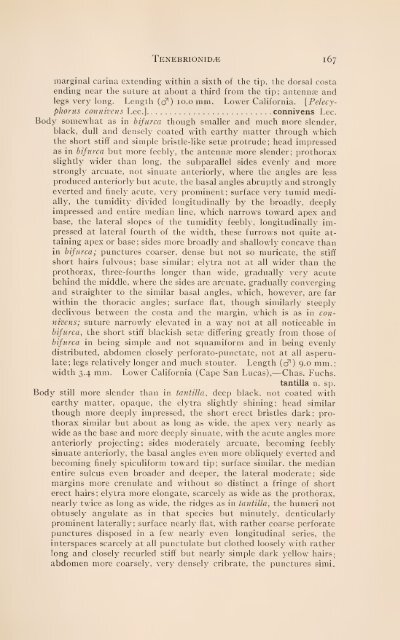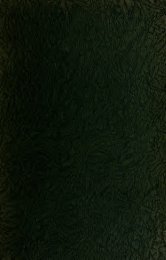Memoirs on the coleoptera
Memoirs on the coleoptera
Memoirs on the coleoptera
You also want an ePaper? Increase the reach of your titles
YUMPU automatically turns print PDFs into web optimized ePapers that Google loves.
TENEBRIONHLE 167<br />
marginal carina extending within a sixth of <strong>the</strong> tip, <strong>the</strong> dorsal costa<br />
ending near <strong>the</strong> suture at about a third from <strong>the</strong> tip; antennae and<br />
legs very l<strong>on</strong>g. Length (c?) 10.0 mm. Lower California. [Pelecyph<strong>on</strong>ts<br />
couiiivens Lee.]<br />
c<strong>on</strong>nivens Lee.<br />
Body somewhat as in bifurca though smaller and much more slender,<br />
black, dull and densely coated with earthy matter through which<br />
<strong>the</strong> short stiff and simple bristle-like setae protrude; head impressed<br />
as in bifurca but more feebly, <strong>the</strong> antennae more slender; prothorax<br />
slightly wider than l<strong>on</strong>g, <strong>the</strong> subparallel sides evenly and more<br />
str<strong>on</strong>gly arcuate, not sinuate anteriorly, where <strong>the</strong> angles are less<br />
produced anteriorly but acute, <strong>the</strong> basal angles abruptly and str<strong>on</strong>gly<br />
everted and finely acute, very prominent; surface very tumid medi-<br />
ally, <strong>the</strong> tumidity divided l<strong>on</strong>gitudinally by <strong>the</strong> broadly, deeply<br />
impressed and entire median line, which narrows toward apex and<br />
base, <strong>the</strong> lateral slopes of <strong>the</strong> tumidity feebly, l<strong>on</strong>gitudinally im-<br />
pressed at lateral fourth of <strong>the</strong> width, <strong>the</strong>se furrows not quite attaining<br />
apex or base; sides more broadly and shallowly c<strong>on</strong>cave than<br />
in bifurca; punctures coarser, dense but not so muricate, <strong>the</strong> stiff<br />
short hairs fulvous; base similar; elytra not at all wider than <strong>the</strong><br />
prothorax, three-fourths l<strong>on</strong>ger than wide, gradually very acute<br />
behind <strong>the</strong> middle, where <strong>the</strong> sides are arcuate, gradually c<strong>on</strong>verging<br />
and straighter to <strong>the</strong> similar basal angles, which, however, are far<br />
within <strong>the</strong> thoracic angles; surface flat, though similarly steeply<br />
declivous between <strong>the</strong> costa and <strong>the</strong> margin, which is as in c<strong>on</strong>-<br />
nivens; suture narrowly elevated in a way not at all noticeable in<br />
bifurca, <strong>the</strong> short stiff blackish setae differing greatly from those of<br />
bifurca in being simple and not squamiform and in being evenly<br />
distributed, abdomen closely perforato-punctate, not at all asperulate;<br />
legs relatively l<strong>on</strong>ger and much stouter. Length (o") 9.0 mm.;<br />
width 3.4 mm. Lower California (Cape San Lucas), Chas. Fuchs.<br />
tantilla n. sp.<br />
Body still more slender than in tantilla, deep black, not coated with<br />
earthy matter, opaque, <strong>the</strong> elytra slightly shining; head similar<br />
though more deeply impressed, <strong>the</strong> short erect bristles dark; prothorax<br />
similar but about as l<strong>on</strong>g as wide, <strong>the</strong> apex very nearly as<br />
wide as <strong>the</strong> base and more deeply sinuate, with <strong>the</strong> acute angles more<br />
anteriorly projecting; sides moderately arcuate, becoming feebly<br />
sinuate anteriorly, <strong>the</strong> basal angles even more obliquely everted and<br />
becoming finely spiculiform toward tip; surface similar, <strong>the</strong> median<br />
entire sulcus even broader and deeper, <strong>the</strong> lateral moderate; side<br />
margins more crenulate and without so distinct a fringe of short<br />
erect hairs; elytra more el<strong>on</strong>gate, scarcely as wide as <strong>the</strong> prothorax,<br />
nearly twice as l<strong>on</strong>g as wide, <strong>the</strong> ridges as in tantilla, <strong>the</strong> humeri not<br />
obtusely angulate as in that species but minutely, denticularly<br />
prominent laterally; surface nearly flat, with ra<strong>the</strong>r coarse perforate<br />
punctures disposed in a few nearly even l<strong>on</strong>gitudinal series, <strong>the</strong><br />
interspaces scarcely at all punctulate but clo<strong>the</strong>d loosely with ra<strong>the</strong>r<br />
l<strong>on</strong>g and closely recurled stiff but nearly simple dark yellow hairs ;<br />
abdomen more coarsely, very densely cribrate, <strong>the</strong> punctures simi.



